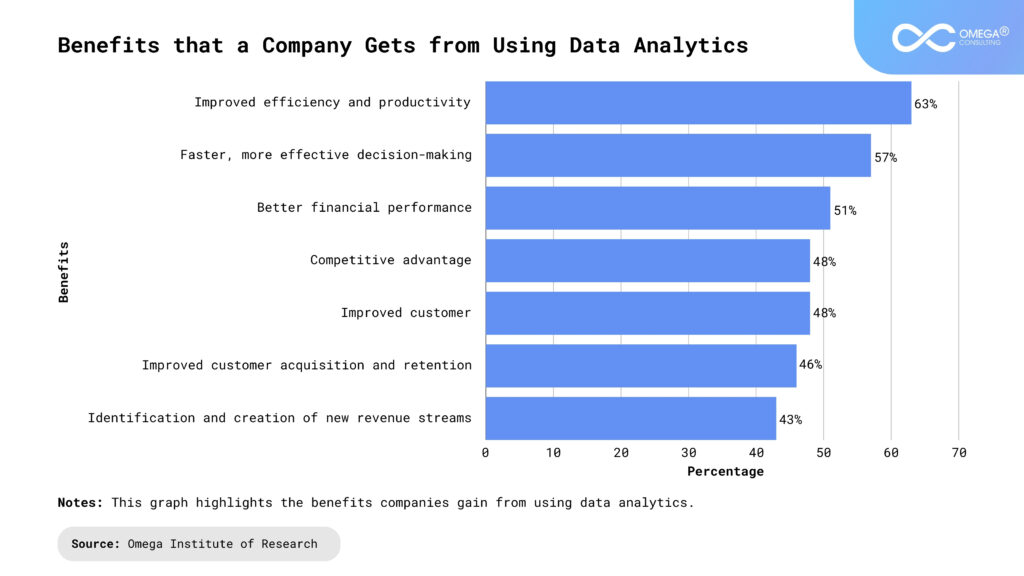- Industries
Industries
- Functions
Functions
- Insights
Insights
- Careers
Careers
- About Us
- Technology
- By Omega Team

Data is frequently referred to as the “new oil” in the context of modern business, a resource so important that it may propel companies to previously unheard-of levels of success. However, data is not intrinsically useful in its unprocessed state, much like oil. Extracting, refining, and processing it is necessary to produce insights that can be put to use. Data analysis is useful in this situation. The foundation of corporate strategy is data analysis, which offers the insights and foresight required to make wise decisions, maximize efficiency, and spur expansion. This article explores the several elements, approaches, and uses of data analysis as it relates to the formation of business strategy.
The Importance of Data Analysis in Business
Decision-Making
Effective decision-making is fundamental to business success. Data analysis provides a solid foundation for decisions, moving away from intuition towards evidence-based strategies. For example, a retail company can use sales data analysis to optimize inventory by identifying best-selling products.

Identifying Trends and Patterns
Data analysis helps uncover trends and patterns that might not be immediately obvious. Recognizing these trends allows businesses to adapt their strategies to meet market demands. For instance, identifying that certain products are seasonal can help businesses manage inventory better.
Enhancing Customer Experience
By understanding customer preferences and behaviors through data analysis, businesses can tailor their offerings. Segmenting customers and predicting their needs enhances satisfaction and loyalty. A company can recommend products based on past purchases, improving the customer experience.
Optimizing Operations
Analyzing operational data identifies bottlenecks and inefficiencies, enabling process optimization. For example, a manufacturing company can reduce production delays by analyzing and addressing stages that cause slowdowns, leading to significant cost savings.
Competitive Advantage
Data analysis provides insights into market trends, customer preferences, and competitor strategies, offering a competitive edge. By staying informed and proactive, businesses can position themselves advantageously and anticipate market changes.
Key Components of Data Analysis
Data Collection
Collecting relevant and accurate data is the first step. Data can be gathered from customer transactions, social media, website analytics, surveys, and more. Tools like Customer Relationship Management (CRM) systems and Enterprise Resource Planning (ERP) systems facilitate data collection.
Data Cleaning
Ensuring data accuracy and consistency involves data cleaning. This process addresses inaccuracies, inconsistencies, and missing values using techniques such as data imputation, normalization, and deduplication. Clean data is crucial for reliable analysis.
Data Exploration
Exploring data helps understand its structure, distribution, and patterns. Descriptive statistics, data visualization, and exploratory data analysis (EDA) techniques are used. Tools like Python’s Pandas library, R, and Tableau assist in this phase.
Data Modeling
Creating mathematical models to represent relationships between variables and predict outcomes is essential. Techniques like regression analysis, classification, clustering, and time series analysis are used. Advanced methods include machine learning and artificial intelligence.
Data Interpretation
Interpreting results to derive actionable insights is the final step. This requires understanding the business context to ensure insights are relevant and can drive strategic decisions, optimizing operations, and enhancing customer experience.

Techniques and Tools for Data Analysis
Descriptive Analytics
Descriptive analytics summarizes historical data to understand past events. Measures like mean, median, mode, standard deviation, and variance describe data, while visualization tools like bar charts, histograms, pie charts, and line graphs present it clearly.
Diagnostic Analytics
Diagnostic analytics identifies why certain events occurred through correlation and causation analysis. Techniques include correlation analysis, hypothesis testing, and root cause analysis, helping businesses address issues and capitalize on opportunities.
Predictive Analytics
Predictive analytics forecasts future outcomes using historical data and statistical models. Techniques like regression analysis, time series analysis, and machine learning algorithms help anticipate trends, identify risks, and make proactive decisions.
Prescriptive Analytics
Prescriptive analytics recommends actions based on analysis using optimization algorithms, simulation models, and decision analysis. This helps optimize resource allocation, streamline operations, and enhance decision-making.
Data Visualization
Data visualization presents data in a visual format to facilitate understanding. Dashboards, charts, graphs, and maps help identify patterns and trends quickly. Tools like Tableau, Power BI, and Google Data Studio are commonly used.
Machine Learning and Artificial Intelligence
Machine learning (ML) and artificial intelligence (AI) enable sophisticated insights by analyzing large data volumes. Techniques include supervised learning, unsupervised learning, and reinforcement learning, applicable in customer segmentation, fraud detection, and predictive maintenance.
Applications of Data Analysis in Business Strategy
Marketing and Customer Insights
Analyzing customer data helps understand behavior and preferences, enabling targeted marketing. Techniques like customer segmentation, sentiment analysis, and predictive modeling optimize strategies, improve engagement, and drive sales.
Supply Chain Management
Optimizing supply chain operations involves analyzing data to identify inefficiencies, predict demand, and optimize inventory. Techniques like demand forecasting, inventory optimization, and supplier performance analysis enhance efficiency and reduce costs.
Financial Planning and Analysis
Financial planning and analysis (FP&A) involves budgeting, forecasting, and financial reporting. Analyzing financial data identifies trends and forecasts performance, supporting strategic decisions. Techniques include financial modeling, variance analysis, and scenario analysis.
Human Resources and Talent Management
HR analytics involves analyzing data to identify talent gaps, optimize workforce planning, and improve employee engagement. Techniques like turnover analysis, performance analysis, and workforce optimization enhance talent acquisition and productivity.
Product Development and Innovation
Product analytics helps understand market trends, evaluate customer feedback, and optimize product development. Techniques like product lifecycle analysis, market segmentation, and innovation diffusion analysis drive innovation and improve product quality.
Risk Management
Risk analytics involves identifying and mitigating risks by analyzing risk data. Techniques like risk assessment, scenario analysis, and stress testing support effective risk management, enhancing resilience and ensuring continuity.

Challenges in Data Analysis
Data Quality and Accuracy
Ensuring data quality and accuracy is challenging but crucial. Inaccurate or incomplete data leads to misleading insights. Robust data cleaning and preprocessing, along with continuous monitoring, address quality issues.
Data Integration and Silos
Integrating data from multiple sources can be complex due to data silos. Robust data management strategies like data warehousing, data lakes, and integration tools are essential for a comprehensive view and accurate insights.
Data Security and Privacy
Ensuring data security and privacy involves robust governance frameworks, encryption, access controls, and compliance with regulations like GDPR and CCPA. Protecting data from breaches and misuse is critical.
Skill Gaps and Talent Shortage
The growing need for specialized skills in statistics, data science, and machine learning creates a talent shortage. Addressing this requires investing in training, fostering a data-driven culture, and leveraging external expertise.
Keeping Up with Technological Advances
Staying updated with evolving tools, techniques, and technologies in data analysis requires continuous learning and adaptation. Investing in modern tools and fostering innovation are crucial for competitiveness.
Case Studies
Retail: Walmart
Context: Walmart, one of the largest retail chains in the world, has been at the forefront of leveraging data analysis to optimize operations and improve customer experience.
Problem: Walmart needed to manage its vast inventory across thousands of stores efficiently and predict customer demand accurately.
Solution: Walmart implemented a data-driven strategy by collecting vast amounts of data from its transactions and supply chain. They utilized predictive analytics to forecast demand and optimize inventory levels. By analyzing point-of-sale data, weather patterns, local events, and social media trends, Walmart could predict which products would be in demand in specific locations.
Outcome: This approach helped Walmart reduce stockouts and overstock situations, leading to significant cost savings. It also improved customer satisfaction by ensuring that popular items were available when customers needed them. Additionally, Walmart’s data analysis capabilities enabled them to respond swiftly to changes in demand patterns, further solidifying their competitive advantage.
Healthcare: Kaiser Permanente
Context:Kaiser Permanente, a leading healthcare provider, sought to enhance patient care and operational efficiency through data analysis.
Problem: Kaiser Permanente faced challenges in predicting patient readmissions and managing the allocation of healthcare resources.
Solution: Kaiser Permanente implemented advanced analytics to analyze patient data, including medical histories, treatment plans, and demographic information. They developed predictive models to identify patients at high risk of readmission and intervened with personalized care plans.
Outcome: The predictive analytics approach led to a significant reduction in patient readmissions, improving patient outcomes and reducing healthcare costs. By targeting high-risk patients with proactive care, Kaiser Permanente was able to allocate resources more effectively and enhance overall operational efficiency.
Finance: JPMorgan Chase
Context: JPMorgan Chase, a global financial services firm, aimed to detect and prevent fraudulent transactions in real-time.
Problem: The financial industry faces constant threats from fraud, and detecting fraudulent activities quickly is critical to minimizing losses.
Solution: JPMorgan Chase leveraged machine learning and artificial intelligence to analyze transaction data in real-time. They developed models that could identify unusual patterns and flag potential fraudulent activities. By analyzing historical transaction data and incorporating behavioral analytics, they improved the accuracy of their fraud detection systems.
Outcome: The implementation of real-time fraud detection systems significantly reduced the incidence of fraudulent transactions. JPMorgan Chase was able to protect its customers’ assets more effectively, enhance trust, and minimize financial losses. The advanced analytics capabilities also allowed them to stay ahead of emerging fraud techniques.
Future Trends in Data Analysis
Artificial Intelligence and Machine Learning
AI and ML are revolutionizing data analysis with automated, real-time, and predictive analytics. These technologies enable deeper insights and smarter decisions, increasingly integrated into analytics platforms.
Big Data and Advanced Analytics
Advanced analytics techniques handle large, complex datasets efficiently. Technologies like distributed computing, cloud analytics, and edge computing, along with techniques like NLP, graph analytics, and deep learning, derive insights from big data.
Data Democratization
Making data and analytics tools accessible across the organization fosters a data-driven culture. Self-service platforms and intuitive visualization tools enable non-technical users to analyze data and make informed decisions.
Real-Time and Streaming Analytics
Real-time insights are crucial for applications like fraud detection and supply chain optimization. Technologies like Apache Kafka and Spark Streaming support real-time and streaming analytics for instant decision-making.
Data Privacy and Ethics
Ethical data practices and compliance with data protection regulations are gaining prominence. Businesses focus on transparent governance, ethical use, and protecting customer privacy, integral to data analysis strategies.
Augmented Analytics
Augmented analytics automates data preparation, insight generation, and decision-making using AI and ML. This enhances efficiency, enabling faster and more accurate insights, supporting informed decisions.
Conclusion
Data analysis is the backbone of business strategy, transforming raw data into actionable insights. From optimizing operations and enhancing customer experience to driving innovation and gaining a competitive edge, data analysis is pivotal for business success. Embracing data-driven strategies and investing in robust data analysis capabilities is essential for thriving in a data-driven era. By leveraging data analysis, businesses can make informed decisions, uncover opportunities, and achieve sustained growth and success.
- https://thebaguide.com/blog/data-analysis-the-backbone-of-business-strategy/
- https://www.lpcentre.com/articles/the-role-of-a-data-analyst-in-shaping-business-strategy
- https://www.linkedin.com/pulse/data-analysis-business-world-unleashing-power-strategic-meenakshi-s-cgwuc/
- https://www.grow.com/blog/data-important-business
- https://www.dataversity.net/developing-a-data-analytics-strategy/
Subscribe
Select topics and stay current with our latest insights
- Functions